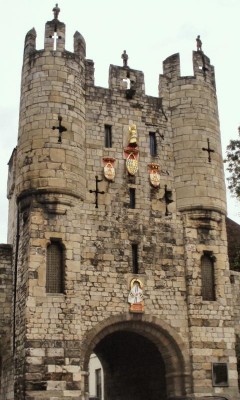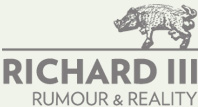Pageant and spectacle

Richard III entered the city through Micklegate Bar on 29 August 1483 to a spectacular welcome of pageantry, speeches and decoration throughout the streets.
© Carolyn Donahue
Associated people
Associated places
Associated institutions
Other articles in this theme:
Description
Richard III was crowned at Westminster Abbey on 6 July 1483. Soon after the magnificent ceremony he went on royal progress northwards to be seen as king across his realm. The journey culminated in a spectacular reception in York, where the king and his entourage arrived on 29 August 1483.
Richard spent three weeks in the city, a stay which was filled with festivity, including welcoming speeches, pageants, gift-giving and feasting. The city had been warned of the royal visit a little over a month earlier but received detailed instructions of the scale and style of display expected just a few days before Richard's arrival.
The king's secretary, John Kendale, wrote to the city council to urge them to put on the most elaborate pageants and finest speeches they could. This was not just to welcome the king but to impress the great lords travelling with him. In particular, an element of north-south competition was used to inspire extra effort in the display, with emphasis placed on the need to welcome the king with a flourish which would dazzle the southern lords in the royal party.
The city government was required to organise the pageantry, including dressing in their ceremonial scarlet to officially receive the king, and ordinary citizens were asked to hang colourful fabrics from their homes to brighten the streets as the king passed through. Much of the display was based on traditional civic pageantry which occurred throughout the year regardless of royal visits.
The royal party was met by civic leaders outside the city walls at St James' church and brought through Micklegate, across Ouse Bridge and along Stonegate to the Minster, with a pageant performed at each of these sites. On arrival at the Minster the king was received at the west door by the dean and canons where he was blessed with holy water before kneeling at the font to recite the prayer 'Our Father'. Services followed which included the psalm of victory, Te Deum, before the royal party processed to the Archbishop's Palace.
The magnificent welcome was highly staged to honour the king and involve the citizens. Care was taken to ensure there was visible support for Richard throughout the city. The king ordered 13,000 badges of his heraldic insignia, the white boar, to be sent to York during his stay for distribution amongst the people.
The centrepiece of the royal visit to the city in 1483 was the investiture of his son as Prince of Wales on 8 September, a lavish event which highlighted the importance of York to the king as well as his son's position in the north.
Sources
Reception of Richard III by civic leaders, 29 August 1483
York House Books, vol 2 p. 288
Richard III's arrival in York, 29 August 1483
York Minster Library, Vicars Choral Statute Book, p. 48, transcript in P.W. Hammond and A.F. Sutton, Richard III The Road to Bosworth Field (London, 1985) pp. 140-41.
Letter to keeper of the wardrobe requesting items of heraldic display, 31 August 1483
British Library Harley MS 433 f. 126, printed in R. Horrox and P.W. Hammond (eds.) British Library Harleian Manuscript 433 (Upminster, 1979-82) vol 2 p. 42
Richard III's entertainments in York, 1483
N. Pronay and J. Cox (eds.) The Crowland Chronicle Continuations: 1459-1486 (London, 1986) p.161
Instructions from the king's secretary on pageantry in York, 24 August 1483
York House Books, vol 2 p. 713

